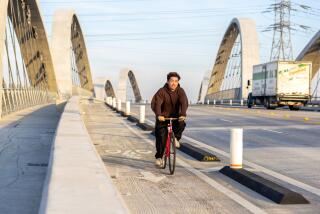Regional Plan With Multiple Options Makes Sense
- Share via
Southern California’s population is expected to grow by more than 6 million people over the next 20 years. Among a growing host of pressing issues, this means we have an urgent need for a rational and mixed transportation system if we’re to avert a congestion and air pollution crisis of major proportions.
The issues of mobility and environmental health are closely linked, not only in our everyday lives but by the fact that any failure in Southern California to meet federal air quality goals by September will mean that we stand to lose billions of dollars in federal funds now slated for transportation projects. No federal money means no real hope to revamp our beleaguered system.
As one of the growing number of folks who actually grew up in Los Angeles, I know it’s important to keep a few realities in mind. Millions of use who own cars in Southern California are simply not going to part with them any time soon. Any regional plan must take into account the extent to which we depend on personal mobility for the zigzag progress we make in any day: to work, child care, shopping, meetings, school, games, second job, etc.
A plan that simply punishes drivers won’t work. Instead, we need to make the options as flexible and attractive as possible and to move travelers, including drivers, quickly and cleanly from place to place.
At the same time, millions of Southern Californians don’t, won’t or can’t afford to drive. They depend on public transit to conduct the business of their lives. These riders need immediate, significant relief from the overcrowding and delays that are not only aggravating but also directly impact their status as wage earners and consumers. Mass transit must be expanded and upgraded and must be more flexible.
Put all these things together and they spell P-L-A-N-N-I-N-G. There must be a regional transportation plan. Not local, regional. The plan must relay on a number of transportation modes and must utilize at least some of the technologically innovative solutions now available to planners.
Current technology provides the ability to give real-time information to commuters on the status of their bus or train as well as fare cards that can be used on any mode of transit to facilitate seamless commuting.
Other innovations represent attempts to think outside the box: smart shuttle programs using jitneys, a sort of public taxi system that picks up and drops off passengers more flexibly; rapid buses being tried on Ventura and Wilshire boulevards; Metrolink connections; fast trains; light rail and (dare I say it?) revisiting the question of subway extensions.
*
In addition to technology and variety in modes of transportation, we must use better management techniques: transportation demand management, such as encouraging telecommuting, ride sharing, four-day work weeks. We need transportation systems management such as traffic signal synchronization, traffic management centers, traffic calming devices. We need priority systems such as high-occupancy vehicle lanes, signal preemption technology, dedicated bus lanes, ramp metering. We need signals and dedicated paths to encourage bicycle and pedestrian transportation where possible; this would also mean paying more attention to smart growth strategies that let us live closer to where we work. We need to explore ITS, or (Intelligent Transportation Systems), such as video surveillance, global positioning systems and computer-aided autos. Instead, of course, people continue to clamor for more freeway lanes, except nobody wants to take a greater bite out the surrounding areas, especially their own. Where do we get more lanes for rapid buses?
Anything is possible, but first there must be a plan.
And a plan is more than the identification of a bewildering assortment of possibilities. It is a set of final decisions.
Unfortunately, that is where the planning process often gets bogged down. There are so many overlapping governments, districts, advocates and detractors that discussions often turn into a modern-day Tower of Babel. Everyone simply repeats their own mantra over and over. Transit corridors lie fallow because planners are unable to figure out what to do with those along the way who don’t want rapid transit running by their houses. Term limits in state and local government mean that natural leaders are gone before the slow creep toward solutions can reach a goal.
*
What is needed is for authority with the greatest scope to have the nerve to pull the parties into a room and say, “You fix it or we’ll fix it for you.” That is just what happened with the impasse on the delivery of water to the state of California. Everything depended on the resolution of what we called the CalFed process. It suffered from the same ennui and then the governor and his staff and the secretary of the interior and his staff stepped in and said, “This is the day we decide on the plan.”
Everyone will be a little bit happy and a little bit unhappy. That is how you know you achieved the correct solution. I know we can do it.
More to Read
Sign up for Essential California
The most important California stories and recommendations in your inbox every morning.
You may occasionally receive promotional content from the Los Angeles Times.










